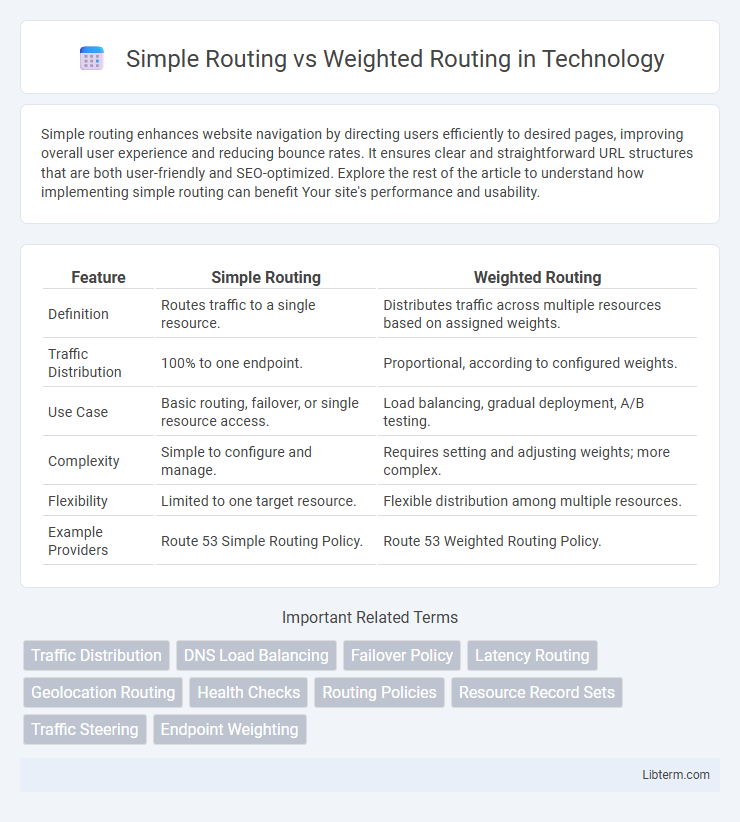Simple routing enhances website navigation by directing users efficiently to desired pages, improving overall user experience and reducing bounce rates. It ensures clear and straightforward URL structures that are both user-friendly and SEO-optimized. Explore the rest of the article to understand how implementing simple routing can benefit Your site's performance and usability.
Table of Comparison
| Feature | Simple Routing | Weighted Routing |
|---|---|---|
| Definition | Routes traffic to a single resource. | Distributes traffic across multiple resources based on assigned weights. |
| Traffic Distribution | 100% to one endpoint. | Proportional, according to configured weights. |
| Use Case | Basic routing, failover, or single resource access. | Load balancing, gradual deployment, A/B testing. |
| Complexity | Simple to configure and manage. | Requires setting and adjusting weights; more complex. |
| Flexibility | Limited to one target resource. | Flexible distribution among multiple resources. |
| Example Providers | Route 53 Simple Routing Policy. | Route 53 Weighted Routing Policy. |
Introduction to Routing Strategies
Simple routing directs traffic to a single endpoint based on a fixed path, ensuring straightforward and predictable traffic management. Weighted routing distributes traffic across multiple endpoints according to specified weights, enabling load balancing and resource optimization. Both strategies are essential in network design for controlling data flow and enhancing application performance.
What is Simple Routing?
Simple Routing directs traffic to a single endpoint based on the target resource's IP address or domain name, ensuring straightforward and efficient request handling. It is ideal for applications needing basic load distribution without complex traffic management or failover policies. Simple Routing is widely used in DNS configurations where all query responses should consistently resolve to one specific resource or server.
What is Weighted Routing?
Weighted routing is a DNS routing policy that distributes traffic across multiple endpoints based on assigned weights, enabling precise control over traffic flow to optimize resource utilization and performance. Each endpoint in weighted routing is given a numerical weight that determines the proportion of traffic directed to it, allowing for gradual traffic shifting or load balancing across servers. This method is particularly effective for managing traffic during deployments, testing new versions, or balancing load between geographically distributed resources.
Key Differences: Simple vs Weighted Routing
Simple routing directs traffic to a single endpoint, providing straightforward management with minimal configuration, ideal for low-complexity applications. In contrast, weighted routing distributes traffic across multiple endpoints based on assigned weights, enabling fine-tuned load balancing and improved fault tolerance. AWS Route 53's weighted routing allows dynamic traffic control, optimizing application performance and availability compared to simple routing's fixed-path approach.
Pros and Cons of Simple Routing
Simple Routing offers straightforward DNS management by directing all traffic to a single resource, which simplifies configuration and reduces the risk of misrouting. However, it lacks the flexibility to distribute traffic across multiple endpoints, potentially leading to resource overload and reduced fault tolerance compared to Weighted Routing. This limitation makes Simple Routing less suitable for applications requiring load balancing or high availability.
Pros and Cons of Weighted Routing
Weighted routing allows traffic distribution across multiple endpoints based on assigned weights, enabling fine-tuned load balancing and traffic management. It provides advantages in optimizing resource utilization and improving fault tolerance by directing more traffic to healthier or higher-capacity servers. However, weighted routing introduces complexity in configuration and maintenance, and misconfigured weights can lead to uneven traffic distribution or degraded performance.
Use Cases for Simple Routing
Simple routing directs traffic to a single resource, making it ideal for straightforward use cases such as serving a static website from one server or directing all traffic to a primary application instance. This routing method is best suited for scenarios where high availability is not a concern or where traffic management complexity needs to be minimal. Simple routing ensures easy setup and maintenance, reducing the risk of misconfiguration in environments with a single endpoint.
Use Cases for Weighted Routing
Weighted routing enables distribution of traffic across multiple endpoints based on assigned weights, allowing controlled load balancing and gradual deployment during application updates. This method is ideal for scenarios such as A/B testing, blue-green deployments, and multi-region failover strategies where precise traffic allocation improves performance and reliability. Simple routing, by contrast, directs all traffic to a single resource without distribution, making it less flexible for dynamic traffic management needs.
Choosing the Right Routing Method
Simple routing directs traffic to a single designated endpoint, offering straightforward management and low latency for uniform workloads. Weighted routing distributes traffic across multiple endpoints based on assigned weights, optimizing resource utilization and enabling gradual deployment or load balancing. Selecting the right method depends on application requirements, with simple routing ideal for single-region services and weighted routing suited for multi-region availability or phased rollouts.
Conclusion: Which Routing Strategy Should You Use?
Simple Routing provides straightforward traffic management by directing all requests to a single resource, making it ideal for applications with low complexity and consistent performance needs. Weighted Routing distributes traffic across multiple resources based on assigned weights, offering enhanced fault tolerance and load balancing suitable for dynamic environments with varying workloads. For scalable and resilient applications requiring traffic distribution and redundancy, Weighted Routing is the preferred strategy, whereas Simple Routing suffices for basic, stable deployments.
Simple Routing Infographic

 libterm.com
libterm.com